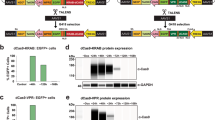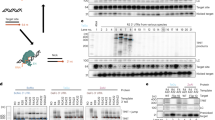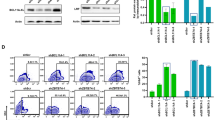Abstract
The two main challenges facing retroviral transgenesis are variable expression and epigenetic silencing. Although modern lentiviral vectors incorporate several elements to increase transgene expression and reduce position effect variegation and silencing, therapeutic research in stem cells, as well as production of transgenic animals, is still hampered by these two key problems. On the basis of recent studies demonstrating the chromatin insulating properties of divergent promoters, we sought to develop a bidirectional lentiviral vector with which to conduct RNA interference (RNAi)-based genetic screens in embryonic and extraembryonic stem cells. To this end, we designed and tested a series of synthetic bidirectional promoters, combining the mouse phosphoglycerate kinase 1 (Pgk1) promoter with other strong mammalian and viral promoters. Here, we demonstrate that a back-to-back configuration of the mouse Pgk1 and human eukaryotic translation elongation factor 1 alpha 1 promoters provided a substantive increase in both transgene expression and RNAi-based transcript depletion as compared with previous designs and other promoter combinations. Using this vector, we were able to achieve stable and robust depletion of a transfected luciferase reporter, as well as an endogenous non-coding RNA. The described constructs are an improved transgene delivery system capable of conducting RNAi screens in stem cells at single copy.
This is a preview of subscription content, access via your institution
Access options
Subscribe to this journal
Receive 12 print issues and online access
$259.00 per year
only $21.58 per issue
Buy this article
- Purchase on Springer Link
- Instant access to full article PDF
Prices may be subject to local taxes which are calculated during checkout






Similar content being viewed by others
References
Edelstein ML, Abedi MR, Wixon J . Gene therapy clinical trials worldwide to 2007—an update. J Gene Med 2007; 9: 833–842.
Kay MA, Glorioso JC, Naldini L . Viral vectors for gene therapy: the art of turning infectious agents into vehicles of therapeutics. Nat Med 2001; 7: 33–40.
Verma IM, Weitzman MD . Gene therapy: twenty-first century medicine. Annu Rev Biochem 2005; 74: 711–738.
Wiznerowicz M, Szulc J, Trono D . Tuning silence: conditional systems for RNA interference. Nat Methods 2006; 3: 682–688.
Lois C, Hong EJ, Pease S, Brown EJ, Baltimore D . Germline transmission and tissue-specific expression of transgenes delivered by lentiviral vectors. Science 2002; 295: 868–872.
Naldini L, Blömer U, Gallay P, Ory D, Mulligan R, Gage FH et al. In vivo gene delivery and stable transduction of nondividing cells by a lentiviral vector. Science 1996; 272: 263–267.
Pfeifer A, Ikawa M, Dayn Y, Verma IM . Transgenesis by lentiviral vectors: lack of gene silencing in mammalian embryonic stem cells and preimplantation embryos. Proc Natl Acad Sci USA 2002; 99: 2140–2145.
Ramezani A, Hawley TS, Hawley RG . Lentiviral vectors for enhanced gene expression in human hematopoietic cells. Mol Ther 2000; 2: 458–469.
D’Costa J, Mansfield SG, Humeau LM . Lentiviral vectors in clinical trials: current status. Curr Opin Mol Ther 2009; 11: 554–564.
Long CR, Tessanne KJ, Golding MC . Applications of RNA interference-based gene silencing in animal agriculture. Reprod Fertil Dev 2010; 22: 47–58.
Singer O, Tiscornia G, Ikawa M, Verma IM . Rapid generation of knockdown transgenic mice by silencing lentiviral vectors. Nat Protoc 2006; 1: 286–292.
Bestor TH . Gene silencing as a threat to the success of gene therapy. J Clin Invest 2000; 105: 409–411.
Baup D, Fraga L, Pernot E, Van Acker A, Vanherck AS, Breckpot K et al. Variegation and silencing in a lentiviral-based murine transgenic model. Transgenic Res 2009; 3: 399–414.
Ellis J, Yao S . Retrovirus silencing and vector design: relevance to normal and cancer stem cells? Curr Gene Ther 2005; 5: 367–373.
Ill CR, Chiou HC . Gene therapy progress and prospects: recent progress in transgene and RNAi expression cassettes. Gene Therapy 2005; 12: 795–802.
Pannell D, Ellis J . Silencing of gene expression: implications for design of retrovirus vectors. Rev Med Virol 2001; 11: 205–217.
Thomas CE, Ehrhardt A, Kay MA . Progress and problems with the use of viral vectors for gene therapy. Nat Rev Genet 2003; 4: 346–358.
Cullen BR, Lomedico PT, Ju G . Transcriptional interference in avian retroviruses--implications for the promoter insertion model of leukaemogenesis. Nature 1984; 307: 241–245.
Curtin JA, Dane AP, Swanson A, Alexander IE, Ginn SL . Bidirectional promoter interference between two widely used internal heterologous promoters in a late-generation lentiviral construct. Gene Therapy 2008; 15: 384–390.
Emerman M, Temin HM . Quantitative analysis of gene suppression in integrated retrovirus vectors. Mol Cell Biol 1986; 6: 792–800.
Adhya S, Gottesman M . Promoter occlusion: transcription through a promoter may inhibit its activity. Cell 1982; 29: 939–944.
Callen BP, Shearwin KE, Egan JB . Transcriptional interference between convergent promoters caused by elongation over the promoter. Mol Cell 2004; 14: 647–656.
Elledge SJ, Davis RW . Position and density effects on repression by stationary and mobile DNA-binding proteins. Genes Dev 1989; 3: 185–197.
Eszterhas SK, Bouhassira EE, Martin DI, Fiering S . Transcriptional interference by independently regulated genes occurs in any relative arrangement of the genes and is influenced by chromosomal integration position. Mol Cell Biol 2002; 22: 469–479.
Martens JA, Laprade L, Winston F . Intergenic transcription is required to repress the Saccharomyces cerevisiae SER3 gene. Nature 2004; 429: 571–574.
Proudfoot NJ . Transcriptional interference and termination between duplicated alpha-globin gene constructs suggests a novel mechanism for gene regulation. Nature 1986; 322: 562–565.
Amendola M, Venneri MA, Biffi A, Vigna E, Naldini L . Coordinate dual-gene transgenesis by lentiviral vectors carrying synthetic bidirectional promoters. Nat Biotechnol 2005; 23: 108–116.
Andrianaki A, Siapati EK, Hirata RK, Russell DW, Vassilopoulos G . Dual transgene expression by foamy virus vectors carrying an endogenous bidirectional promoter. Gene Therapy 2010; 17: 380–388.
Antoniou M, Harland L, Mustoe T, Williams S, Holdstock J, Yague E et al. Transgenes encompassing dual-promoter CpG islands from the human TBP and HNRPA2B1 loci are resistant to heterochromatin-mediated silencing. Genomics 2003; 82: 269–279.
Germann UA, Chin KV, Pastan I, Gottesman MM . Retroviral transfer of a chimeric multidrug resistance-adenosine deaminase gene. FASEB J 1990; 4: 1501–1507.
Hennecke M, Kwissa M, Metzger K, Oumard A, Kröger A, Schirmbeck R et al. Composition and arrangement of genes define the strength of IRES-driven translation in bicistronic mRNAs. Nucleic Acids Res 2001; 29: 3327–3334.
Ibrahimi A, Vande Velde G, Reumers V, Toelen J, Thiry I, Vandeputte C et al. Highly efficient multicistronic lentiviral vectors with peptide 2A sequences. Hum Gene Ther 2009; 20: 845–860.
Kozak M . Alternative ways to think about mRNA sequences and proteins that appear to promote internal initiation of translation. Gene 2003; 318: 1–23.
Liu B, Paton JF, Kasparov S . Viral vectors based on bidirectional cell-specific mammalian promoters and transcriptional amplification strategy for use in vitro and in vivo. BMC Biotechnol 2008; 8: 49.
Mizuguchi H, Xu Z, Ishii-Watabe A, Uchida E, Hayakawa T . IRES-dependent second gene expression is significantly lower than cap-dependent first gene expression in a bicistronic vector. Mol Ther 2000; 1: 376–382.
Williams S, Mustoe T, Mulcahy T, Griffiths M, Simpson D, Antoniou M et al. CpG-island fragments from the HNRPA2B1/CBX3 genomic locus reduce silencing and enhance transgene expression from the hCMV promoter/enhancer in mammalian cells. BMC Biotechnol 2005; 5: 17.
Zhang F, Frost AR, Blundell MP, Bales O, Antoniou MN, Thrasher AJ . A ubiquitous chromatin opening element (UCOE) confers resistance to DNA methylation-mediated silencing of lentiviral vectors. Mol Ther 2010; 18: 1640–1649.
Furler S, Paterna JC, Weibel M, Büeler H . Recombinant AAV vectors containing the foot and mouth disease virus 2A sequence confer efficient bicistronic gene expression in cultured cells and rat substantia nigra neurons. Gene Therapy 2001; 8: 864–873.
Adachi N, Lieber MR . Bidirectional gene organization: a common architectural feature of the human genome. Cell 2002; 109: 807–809.
Cawley S, Bekiranov S, Ng HH, Kapranov P, Sekinger EA, Kampa D et al. Unbiased mapping of transcription factor binding sites along human chromosomes 21 and 22 points to widespread regulation of noncoding RNAs. Cell 2004; 116: 499–509.
Takai D, Jones PA . Origins of bidirectional promoters: computational analyses of intergenic distance in the human genome. Mol Biol Evol 2004; 21: 463–467.
Trinklein ND, Aldred SF, Hartman SJ, Schroeder DI, Otillar RP, Myers RM . An abundance of bidirectional promoters in the human genome. Genome Res 2004; 14: 62–66.
Golding MC, Zhang L, Mann MR . Multiple epigenetic modifiers induce aggressive viral extinction in extraembryonic endoderm stem cells. Cell Stem Cell 2010; 6: 457–467.
Chang K, Elledge SJ, Hannon GJ . Lessons from Nature: microRNA-based shRNA libraries. Nat Methods 2006; 3: 707–714.
Dickins RA, Hemann MT, Zilfou JT, Simpson DR, Ibarra I, Hannon G et al. Probing tumor phenotypes using stable and regulated synthetic microRNA precursors. Nat Genet 2005; 37: 1289–1295.
Dickins RA, McJunkin K, Hernando E, Premsrirut PK, Krizhanovsky V, Burgess DJ et al. Tissue-specific and reversible RNA interference in transgenic mice. Nat Genet 2007; 39: 914–921.
Schlabach MR, Luo J, Solimini NL, Hu G, Xu Q, Li MZ et al. Cancer proliferation gene discovery through functional genomics. Science 2008; 319: 620–624.
Silva JM, Li MZ, Chang K, Ge W, Golding MC, Rickles RJ et al. Second-generation shRNA libraries covering the mouse and human genomes. Nat Genet 2005; 37: 1281–1288.
Silva JM, Marran K, Parker JS, Silva J, Golding M, Schlabach MR et al. Profiling essential genes in human mammary cells by multiplex RNAi screening. Science 2008; 319: 617–620.
Zender L, Spector MS, Xue W, Flemming P, Cordon-Cardo C, Silke J et al. Identification and validation of oncogenes in liver cancer using an integrative oncogenomic approach. Cell 2006; 125: 1253–1267.
Zender L, Xue W, Zuber J, Semighini CP, Krasnitz A, Ma B et al. An oncogenomics-based in vivo RNAi screen identifies tumor suppressors in liver cancer. Cell 2008; 135: 852–864.
Cherry SR, Biniszkiewicz D, van Parijs L, Baltimore D, Jaenisch R . Retroviral expression in embryonic stem cells and hematopoietic stem cells. Mol Cell Biol 2000; 20: 7419–7426.
Alexopoulou AN, Couchman JR, Whiteford JR . The CMV early enhancer/chicken beta actin (CAG) promoter can be used to drive transgene expression during the differentiation of murine embryonic stem cells into vascular progenitors. BMC Cell Biol 2008; 9: 2.
Hong S, Hwang DY, Yoon S, Isacson O, Ramezani A, Hawley RG et al. Functional analysis of various promoters in lentiviral vectors at different stages of in vitro differentiation of mouse embryonic stem cells. Mol Ther 2007; 15: 1630–1639.
Stegmeier F, Hu G, Rickles RJ, Hannon GJ, Elledge SJ . A lentiviral microRNA-based system for single-copy polymerase II-regulated RNA interference in mammalian cells. Proc Natl Acad Sci USA 2005; 102: 13212–13217.
Ventura A, Meissner A, Dillon CP, McManus M, Sharp PA, Van Parijs L et al. Cre-lox-regulated conditional RNA interference from transgenes. Proc Natl Acad Sci USA 2004; 101: 10380–10385.
Ward CM, Stern PL . The human cytomegalovirus immediate-early promoter is transcriptionally active in undifferentiated mouse embryonic stem cells. Stem Cells 2002; 20: 472–475.
Furth PA, Hennighausen L, Baker C, Beatty B, Woychick R . The variability in activity of the universally expressed human cytomegalovirus immediate early gene 1 enhancer/promoter in transgenic mice. Nucleic Acids Res 1991; 19: 6205–6208.
McBurney MW, Staines WA, Boekelheide K, Parry D, Jardine K, Pickavance L . Murine PGK-1 promoter drives widespread but not uniform expression in transgenic mice. Dev Dyn 1994; 200: 278–293.
Schmidt EV, Christoph G, Zeller R, Leder P . The cytomegalovirus enhancer: a pan-active control element in transgenic mice. Mol Cell Biol 1990; 10: 4406–4411.
Biffi A, Capotondo A, Fasano S, del Carro U, Marchesini S, Azuma H et al. Gene therapy of metachromatic leukodystrophy reverses neurological damage and deficits in mice. J Clin Invest 2006; 116: 3070–3082.
Laker C, Meyer J, Schopen A, Friel J, Heberlein C, Ostertag W et al. Host cis-mediated extinction of a retrovirus permissive for expression in embryonal stem cells during differentiation. J Virol 1998; 72: 339–348.
Ellis J . Silencing and variegation of gammaretrovirus and lentivirus vectors. Hum Gene Ther 2005; 16: 1241–1246.
Golding MC, Long CR, Carmell MA, Hannon GJ, Westhusin ME . Suppression of prion protein in livestock by RNA interference. Proc Natl Acad Sci USA 2006; 103: 5285–5290.
Georgiades P, Cox B, Gertsenstein M, Chawengsaksophak K, Rossant J . Trophoblast-specific gene manipulation using lentivirus-based vectors. Biotechniques 2007; 42: 317–325.
Okada Y, Ueshin Y, Isotani A, Saito-Fujita T, Nakashima H, Kimura K et al. Complementation of placental defects and embryonic lethality by trophoblast-specific lentiviral gene transfer. Nat Biotechnol 2007; 25: 233–237.
Zhang B, Xia HQ, Cleghorn G, Gobe G, West M, Wei MQ . A highly efficient and consistent method for harvesting large volumes of high-titre lentiviral vectors. Gene Therapy 2001; 8: 1745–1751.
Caspary T, Cleary MA, Baker CC, Guan XJ, Tilghman SM . Multiple mechanisms regulate imprinting of the mouse distal chromosome 7 gene cluster. Mol Cell Biol 1998; 18: 3466–3474.
Fitzpatrick GV, Soloway PD, Higgins MJ . Regional loss of imprinting and growth deficiency in mice with a targeted deletion of KvDMR1. Nat Genet 2002; 32: 426–431.
Lewis A, Green K, Dawson C, Redrup L, Huynh KD, Lee JT et al. Epigenetic dynamics of the Kcnq1 imprinted domain in the early embryo. Development 2006; 133: 4203–4210.
Terranova R, Yokobayashi S, Stadler MB, Otte AP, van Lohuizen M, Orkin SH et al. Polycomb group proteins Ezh2 and Rnf2 direct genomic contraction and imprinted repression in early mouse embryos. Dev Cell 2008; 15: 668–679.
Lindahl Allen M, Antoniou M . Correlation of DNA methylation with histone modifications across the HNRPA2B1-CBX3 ubiquitously-acting chromatin open element (UCOE). Epigenetics 2007; 2: 227–236.
Hannon GJ, Rossi JJ . Unlocking the potential of the human genome with RNA interference. Nature 2004; 431: 371–378.
Guttman M, Amit I, Garber M, French C, Lin MF, Feldser D et al. Chromatin signature reveals over a thousand highly conserved large non-coding RNAs in mammals. Nature 2009; 458: 223–227.
Rinn JL, Kertesz M, Wang JK, Squazzo SL, Xu X, Brugmann SA et al. Functional demarcation of active and silent chromatin domains in human HOX loci by noncoding RNAs. Cell 2007; 129: 1311–1323.
Rubinson DA, Dillon CP, Kwiatkowski AV, Sievers C, Yang L, Kopinja J et al. A lentivirus-based system to functionally silence genes in primary mammalian cells, stem cells and transgenic mice by RNA interference. Nat Genet 2003; 33: 401–406.
Acknowledgements
We thank GJ Hannon for reagents. This work was supported by Research Grant MOP-81167 from the Canadian Institute of Health Research, and grants from Lawson Health Research Institute, and Department of Obstetrics and Gynecology, University of Western Ontario. MRWM was supported by the Ontario Women's Health Council/CIHR Institute of Gender and Health New Investigator Award. MCG was supported by the Ontario Women's Health Council/CIHR Institute of Gender and Health Fellowship Award and the Dr David Whaley Postdoctoral Fellowship in Maternal/Fetal and Neonatal Research.
Author information
Authors and Affiliations
Corresponding author
Ethics declarations
Competing interests
The authors declare no conflict of interest.
Rights and permissions
About this article
Cite this article
Golding, M., Mann, M. A bidirectional promoter architecture enhances lentiviral transgenesis in embryonic and extraembryonic stem cells. Gene Ther 18, 817–826 (2011). https://doi.org/10.1038/gt.2011.26
Received:
Revised:
Accepted:
Published:
Issue Date:
DOI: https://doi.org/10.1038/gt.2011.26



